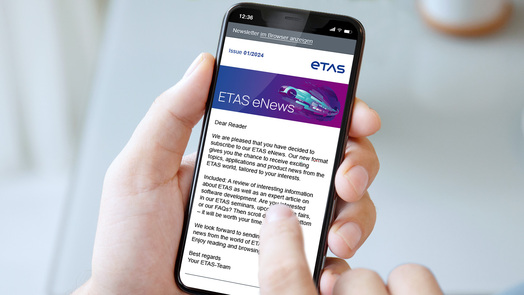12/09/2024
A 15-year journey of innovation and collaboration in the automation of automotive calibration and testing
INCA-FLOW

INCA-FLOW is an intuitive tool that enables engineers to model calibration procedures with a graphic design editor and then execute them on the connected infrastructure. The success story of this tool goes hand in hand with the partnership with IAV, which continues to these days.
The beginning of a strong partnership
In 2009 IAV approached ETAS with their solution for an automated tool for calibration tasks. This led to a cooperation agreement and a contract signed on December 14, with a defined division of work: IAV focused on development, while ETAS took care of sales, marketing, and first-level support, with joint requirements management.
The tool was originally called CaliAV. After a few years, ETAS fully adopted the tool into its portfolio – IAV continues to be a strong partner for the continuous development of the tool. The name of the tool was changed in mid-2013 to the now familiar name of INCA-FLOW.
A brief history of the collaboration
It’s incredible to think that so many years have passed since the inception of INCA-FLOW and the beginning of the partnership with IAV. But the success story began much earlier: In 1999, ETAS INCA V2.1.1 was released, which included the first INCA API. This was used by an IAV engineer in a project for IAV Inc. to integrate the first variable camshaft system in the engine family of a big OEM (original equipment manufacturer) in the U.S. The project involved repetitive test and calibration scenarios at an engine dynamometer, with scripts used for automated optimization of the camshaft control system via third-party APIs for ETAS INCA.
In 2003, back at IAV GmbH in Germany, the methodology was improved with numerous PoC (proof of concept) development tasks for several calibration applications, which resulted in the concept being structured in a state “flow” environment. The challenges of an oversized third-party solution and the handling of syntax/semantics with the APIs of ETAS INCA spawned the idea of developing a dedicated framework for the calibration of embedded systems based on a native programming language.
IAV set up a working group with experienced calibration engineers and software engineers to develop the framework, which was successively developed with features like a graphical flow chart-based calibration process design and a direct connection to the well-established MCD (measurement, calibration and diagnostic) tool ETAS INCA. This laid the foundations for INCA-FLOW.
The success of INCA-FLOW
INCA-FLOW has had widespread adoption, being utilized by approximately 100 automakers and suppliers, with over 1,500 users across the globe and a presence in numerous countries. Over the past 15 years, the tool has undergone more than 30 product software updates, with the new INCA-FLOW v4.18 set to be released before the end of the year. During this time, the number of toolboxes, which contain specific pre-defined libraries, has increased to nine.
The success of INCA-FLOW can be attributed to its adaptability to the evolving requirements of the automotive industry. The tool has standardized and automated application and validation processes, resulting in shorter development times, reduced costs, and improved calibration quality. Notably, customers have reported significant efficiency gains, with non-experts who use INCA-FLOW in a testbench environment saving up to 50 percent on testing time compared to experts without it.
INCA-FLOW has evolved into an intuitive and versatile tool that empowers a wide range of professionals – including calibration engineers, function developers, software developers, and project managers – to model calibration procedures with a graphic design editor and execute them seamlessly. It can be used in various contexts such as XiL (model, software and hardware in the loop), testbench, and vehicle-testing environments, supporting diverse powertrain systems, and for transmission and component use-cases.
The tool caters to a diverse range of applications, including on-road vehicles, off-road vehicles, snowmobiles, and marine engines. Its stand-alone interpreter enables modeling in the laboratory and handoff to test drivers, even from other companies and countries, enabling a job split or tailoring.
To another 15 years!
Beyond its broad customer and use-case base, INCA-FLOW is used within IAV by a wide calibration community. It has addressed upcoming topics such as BEV-related issues and XiL-based development, with specific solutions for the evaluation of BEV measurement data and the integration of the ASAM XiL interface. Additionally, it has successfully integrated interfaces to other ETAS solutions like ETAS ASCMO or COSYM within the toolchain. The tool is also addressing new topics for SDV (software-defined vehicle)-related tool solutions and AI topics, thus aiming in the future to enhance the tool with a seamless connection to engineering requirement tools supported by AI-based algorithms.
ETAS and IAV have wonderful opportunities in the future based on 15 years of successful cooperation. IAV is focusing on the continuous further development of the tool with ETAS as a strong sales partner at its side. As they reflect on their achievements, both companies are excited about the prospect of many more years of working together, driving innovation, and continuing to provide new solutions for their customers.


